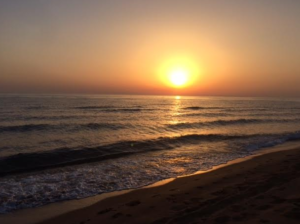
by Olivia Conway, co-online editor
Before stepping off the plane in Athens, all that I knew about Greece came from lessons on ancient civilizations, listening to my parents’ philosophical discussions, and Rick Riordan’s Percy Jackson & the Olympians series. While I knew that Greece was as much of a modern country as the United States, I could not shake the ideas of gleaming white columns and small city-states dedicated to polytheism. In reality, Athens was an intriguing blend of ancient and new: the hotel I stayed in the first night displayed examples of ancient pottery and the Parthenon was ever present on the horizon, gloriously presiding over the bustling city of Athens.
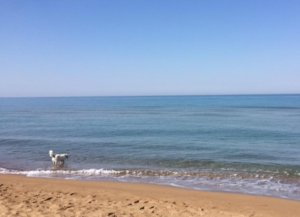
While the Greek islands are an extremely popular vacation destination, I traveled to Greece for different reasons. I had signed up to spend two weeks camping on Kyparissia Bay and monitoring the endangered loggerhead turtles, or Caretta caretta, during their nesting season. A few things I learned about camping: 1) Sleeping on the ground is not comfortable, even with an air mattress 2) even if you are not on the beach, sand will be everywhere 3) at a certain point, insects in your tent become a minor annoyance instead of an earth shattering catastrophe. But, the grittiness of the sand and the unforgiving ground were worth the once in a lifetime experience of participating in an actual conservation project.
I met people from all over the world who all shared a similar interest in protecting marine life. We participated in morning and night surveys to collect data, protect turtle nests, and observe the nesting turtles.
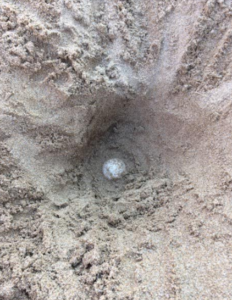
Morning surveys started around 6:00 or 6:30 am and I and fellow volunteers would walk along the beach searching for turtle tracks and nests. If we found a nest we would dig in the sand until we found eggs, then proceeding to take various measurements such as the distance from the top egg to the level sand, the distance from the nest to the surf, and the exact location of the nest on the beach. If the nest was too close to the surf then we would perform a relocation and move the eggs to a safer location. Relocations were important because if the eggs were too close to the water, the waves could drown the baby turtles before they hatched. We recorded all measurements, as well as notes on the time of day and weather, in a book that would later be compiled with other data. After taking measurements and ensuring the eggs didn’t need to be relocated, we recovered the eggs with sand and placed a metal grate secured with bamboo over the nest to prevent dogs and other predators from digging up the eggs. Each nest was also affixed with a sign written in both Greek and English, explaining that the nest was protected and should not be touched. There are worse ways to spend a morning than walking on a Greek beach at sunrise.
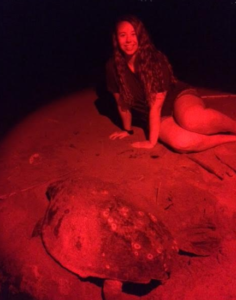
Night surveys started around 10:30 p.m. and could last up to four hours depending on turtle activity. During a night survey, we walked up and down the beach with red flashlights, because red is the least obtrusive color of light, looking for nesting loggerheads. If we found a nesting turtle, we would wait for her to dig her egg chamber in the sand and then watch as she laid her eggs.
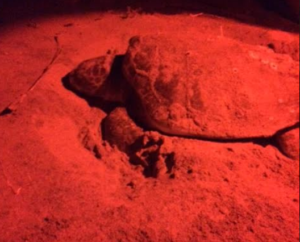
Loggerheads fall into a kind of trance while laying eggs, allowing us to get a close up view of the nest and eggs. Once she began to cover up her nest, which is known as camouflaging, we proceeded to take measurements of her length and width, tag her if she did not already have tags, and check her shell for any injuries or scars. Loggerhead turtles always nest on the beach where they were born and they return year after year to roughly the same spot to lay their eggs, so we used the tags to monitor which turtles were returning and how their egg laying process changed over time.
Seeing my first turtle was one of the most special moments of my life. I watched from nearby in the sand as the turtle shuffled around the beach, looking for the perfect spot to make her nest. She was illuminated by the moon, which was so bright I could see my shadow on the beach, and I was struck by the magic and mystery of the scene–I was observing a turtle as she tried to dig an egg chamber in the sand, just as her ancestors had done for millennia and many more would do after her. In the end, she decided not to lay her eggs that night and instead made her way back to the sea. We followed her to the water and watched as she disappeared beneath the waves. Later that night we did see a turtle lay her eggs and I marveled at the beauty of evolution. Turtle eggs are soft and springy, expertly designed by nature to survive the drop into the egg chamber, and through instinct alone, the hatchlings will know to crawl out of the sand in about sixty days time and hurry to the ocean.

On the weekend, we took trips to Greek castles and other towns near the coast. I was in awe of the sprawling castle grounds and crumbling walls that had lasted for hundreds of years. The picturesque image was completed by the beautiful blue of the water and the reassuring crash of waves just beyond the castle walls. The inside of the castle was wonderfully aesthetically pleasing with towering archways and windows overlooking the sea. Visiting my first castle was certainly an unforgettable experience. After walking through the castles we would travel to neighboring towns to shop and eat traditional Greek foods. My favorite food from this trip was probably the pita wraps, a warm piece of pita with tomatoes, lettuce, feta cheese, tzatziki sauce, and french fries (!!!!!). Eating a pita wrap was a defining moment in my life and I don’t think I will ever be the same again. They are seriously the food of the gods and I am honored that I was deemed worthy enough to taste one.
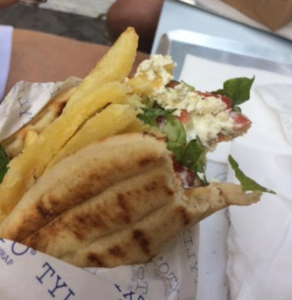
After completing my turtle project, I spent a few days in Athens with my parents. Athens was fascinating because I would be walking along a modern street filled with shops and people and suddenly stumble into some ancient ruins in the middle of the road. While my project was more of a hands-on experience type of trip, my days in Athens were devoted to visiting historical and educational sites.
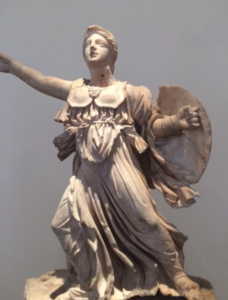
I visited an archaeology museum that was filled to the brim with Greek, Roman/Byzantine, and Egyptian artifacts. I saw statues of gods and goddesses from ancient times, stunningly beautiful pieces of jewelry and pottery, and intricately painted sarcophagi. Speaking as someone with almost zero artistic talent, I was in awe of the tiny details on the marble slabs and sculptures. I also went to a museum of Cycladic art, which was strange but just as beautiful as the exhibits in the archaeology museum. Cycladic art was popular almost five thousand years ago and it is characterized by extremely simple sculptures of
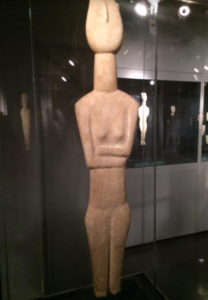
humans, usually women. The Cycladic sculptures are usually devoid of any facial features besides a prominent nose and stand with their arms folded over their torsos. While other Greek artifacts are stunning in their intricacies, these sculptures are beautiful because of their simplicity. I also ate more pita wraps and drank so much orange juice that instead of blood, I think there is fresh-squeezed orange juice flowing through my veins.
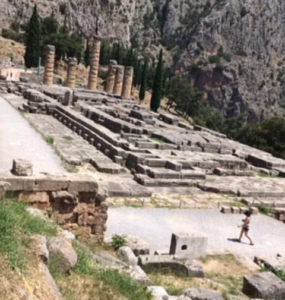
On my second full day in Greece, my parents and I decided to visit the temple at Delphi, the destination of many ancient Greek pilgrimages. Citizens would travel from all over to the so-called “center of the world” to ask questions of the Pythia, hoping for some insight into their futures. The area is important both historically and religiously since the temple became a gathering spot for scholars and a major archaeological site as well as the home of the Pythia, who was believed to be a priestess of Apollo. The view was breathtakingly beautiful. The temple sat high in the hills and I could see a vast grove of olive trees and a beautiful blue coast from where I stood. I also decided it would be a great idea to hike all the way up to the ancient stadium that had once been used for sporting events. Honestly, the climb up the steep path was a workout enough and I couldn’t imagine participating in some kind of track event immediately afterwards. The view was worth it though, as I could see even more of the surrounding valley than before. While I did not feel compelled to shout a question into the impressive ruins of the temple, I was honored to stand in such an important cultural and historical location.
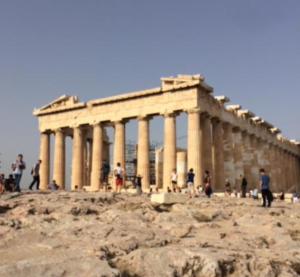
I spent my last morning in Greece at the Parthenon, the ancient temple dedicated to Athena. Once again, I climbed a steep hill, but was rewarded with a stunning view of Athens spread out below me. The Parthenon was an impressive structure, but the cranes and scaffolding used for restoration kind of detracted from its prestige and mystique. I had seen the Parthenon sparkling on the hilltop since I arrived in Athens and seeing it up close was an amazing experience. I still cannot believe that the Ancient Greek architects were able to build such beautiful and long lasting structures. The Parthenon was surrounded by smaller temples, all of which displayed soaring columns and carefully carved facades that have survived for millennia, through countless storms and invasions.
Overall, I hope to return to Greece in the future. After years of reading Greek mythology and learning the history of the Ancient Greek city-states, visiting Greece was a dream come true. I loved seeing the birthplace of science, democracy, philosophy, and art and working with the loggerhead turtles simply made my trip even more special and unforgettable.

